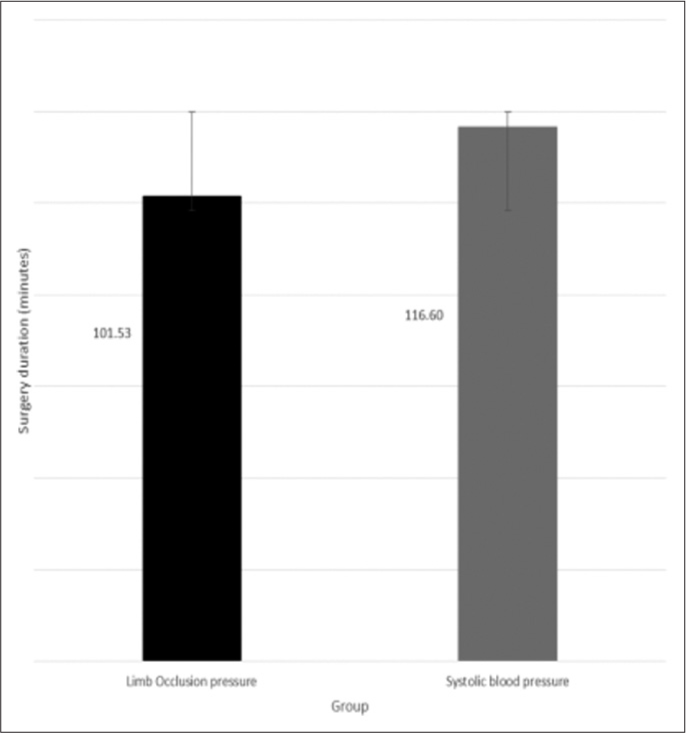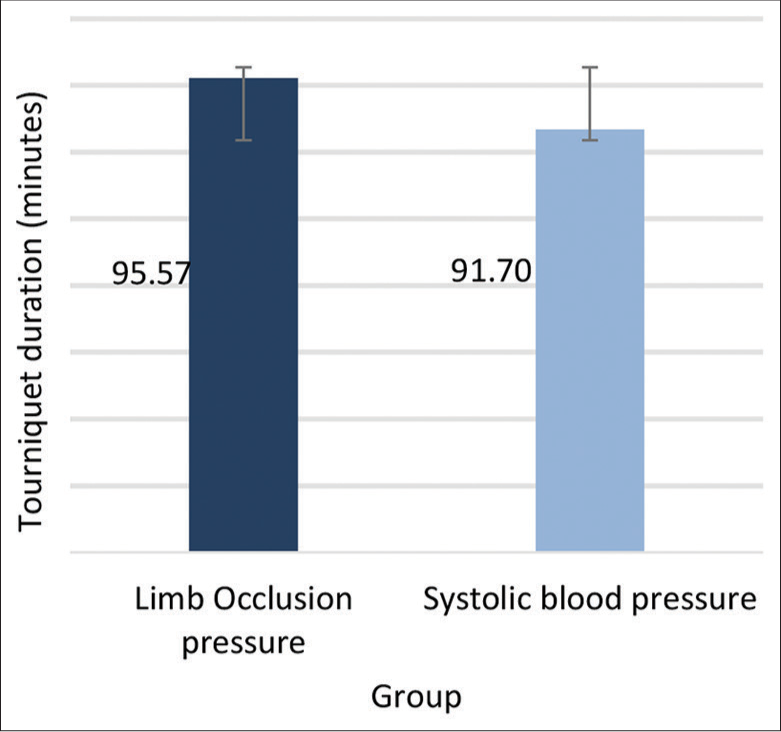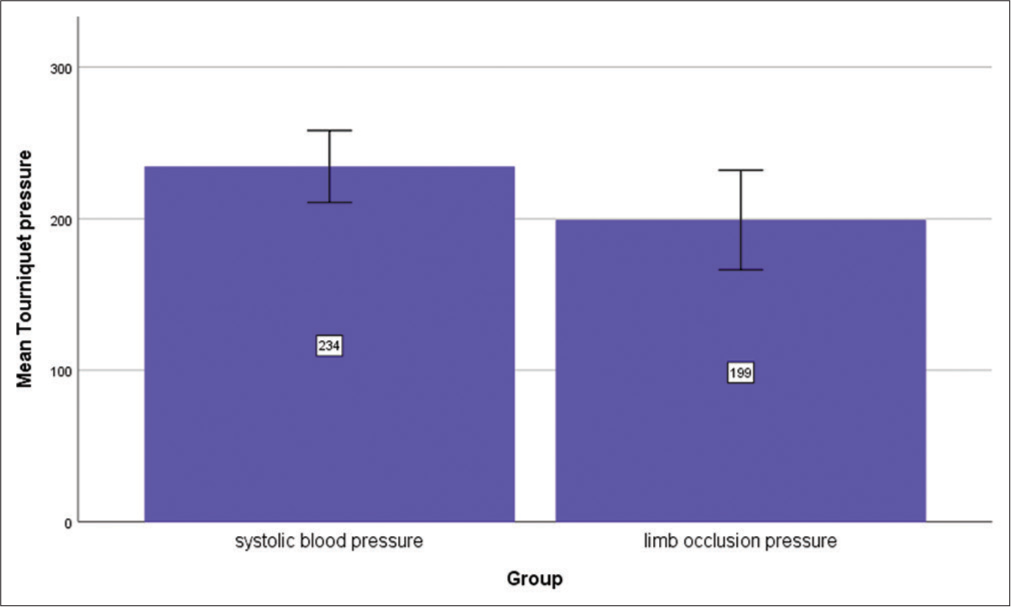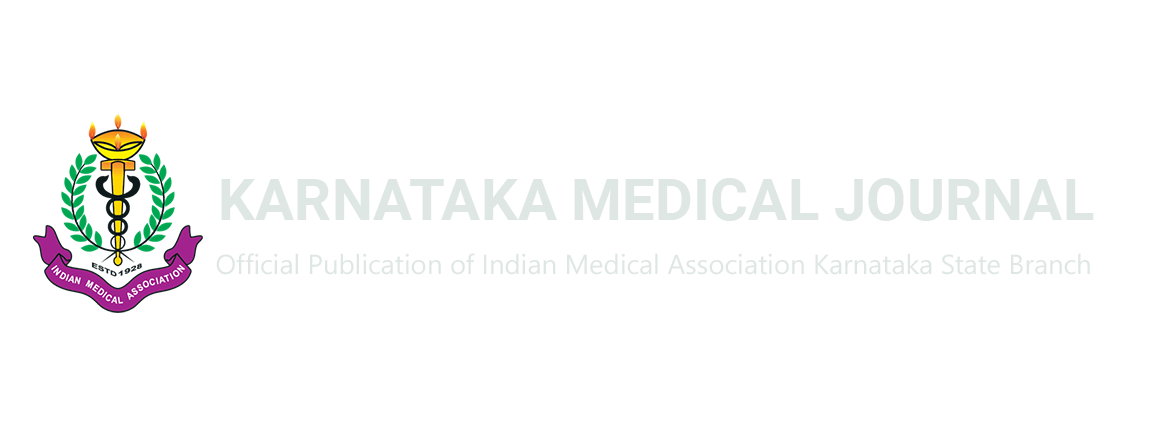Translate this page into:
Comparison of the systolic blood pressure and limb occlusion pressure methods in determining effective tourniquet pressure in upper limb surgeries
*Corresponding author: Joseph Asuquo, Department of Orthopaedics and Traumatology, University of Calabar, Calabar, Nigeria. itansuq@yahoo.com
-
Received: ,
Accepted: ,
How to cite this article: Akah CM, Lasebikan OA, Asuquo J, Katchy UA, Anyaehie UE, Uzodimma SC, et al. Comparison of the systolic blood pressure and limb occlusion pressure methods in determining effective tourniquet pressure in upper limb surgeries. Karnataka Med J. 2024;47:9-14. doi: 10.25259/KMJ_20_2024
Abstract
Introduction:
The importance of a tourniquet to a surgeon cannot be overemphasised. Pneumatic tourniquet pressure is usually determined by systolic blood pressure (SBP), but a new emerging method, the limb occlusion pressure (LOP) appears more promising, especially in upper limb surgeries. We compare the effectiveness of the SBP and LOP methods in determining the tourniquet pressure in forearm bone surgeries.
Material and Methods:
This study was a prospective comparative study involving 60 forearm bone surgeries conducted over a 1-year period with randomisation into two groups. Those whose tourniquet pressure was determined using the SBP method (Group A) and those whose pressure was determined using the LOP method (Group B). Data collected included the tourniquet pressure, tourniquet performance using a Likert scale as well as tourniquet-related complications were noted. Analysis was done with the Statistical Package for the Social Sciences (version 22 trademark of the International Business Machine) and Excel (version 13.0, Microsoft, Redmond, WA).
Results:
There was a statistically significant difference in the mean tourniquet pressure between the two groups (SBP = 234.43 ± 11.87 mmHg; LOP = 199.17 ± 16.44 mmHg, P < 0.001). Both methods provided a satisfactory dry field throughout the tourniquet duration with no statistically significant difference in the tourniquet performance between the two groups. Although two cases of tourniquet-related nerve palsy were noted in the SBP group, it was not statistically significant (P = 0.355).
Conclusion:
The LOP method provided a satisfactory dry surgical field at a lower tourniquet pressure than the SBP method with no complications.
Keywords
Tourniquet
Upper limb
Limb occlusion pressure
Pneumatic
INTRODUCTION
A pneumatic tourniquet is widely used in orthopaedic surgery especially while operating on the limbs.[1] It is a constricting or compressing device used to control blood flow to an extremity for a period of time.[1] It makes for a relatively dry field allowing surgical procedures to be performed with improved precision, safety and speed.[2] Compression of the tissues beneath the tourniquet is associated with damage to the underlying skin, muscles, vessels and most importantly, nerves, with nerve injury being the most common complication of tourniquet use in upper extremity surgery.[1] Nerve palsy has been directly linked to excessive tourniquet pressure.[1] While using a tourniquet, the goal should be the use of the minimum pressure that achieves a relatively dry field to minimise complications.[3]
It is thus not surprising that different methods exist to determine the tourniquet pressure.[4-6] The commonest method used in our region is the systolic blood pressure (SBP) method.[5] Here, 75–100 mmHg and 100–150 mmHg is added to the SBP for the upper limb and lower limb, respectively.[4,7] Complications have been reported with this method.[5]
Another method is the limb occlusion pressure (LOP) method.[8,9] The LOP is the tourniquet pressure required to cease arterial blood flow into the extremity distal to the point of tourniquet application.[1,9] This method takes into cognizance the peculiarities of the patient, that of the particular limbs as well as the physical attributes of the tourniquet and has been adjudged to be more efficient.[1,3,10]
As at the time of writing, there was no published study directly comparing the two methods. Hence, the study aims to compare the SBP and the LOP methods of determining the tourniquet pressure in adult upper-limb surgeries in terms of tourniquet pressure, tourniquet performance as well as tourniquet-related complications.
AIMS AND OBJECTIVES
To compare the SBP and the LOP methods of determining the tourniquet pressure in adult upper-limb surgeries. To assess Tourniquet performance in both methods. To determine effective tourniquet pressure using both methods. To document tourniquet related complications in both methods.
MATERIAL AND METHODS
It was a prospective comparative study conducted within 12 months at National Orthopaedic Hospital Enugu. Patients who met the inclusion criteria were systematically sampled. They were consecutively numbered. The odd numbers were in Group A while the even numbers were placed in Group B. In Group A, the tourniquet pressure was determined using the SBP method. In Group B, the pressure was determined using the LOP method. The patient as well as the surgeons performing the surgery were blinded the group each patient belonged to.
Informed consent was obtained from 60 patients with upper-limb (elbow to wrist) bony pathologies. Exclusion criteria included patients with compromised skin at the proposed site of application of the tourniquet and those in whom mechanical exsanguinations were contraindicated: Severe peripheral vascular disease, severe crush injury to the limb, limb malignancy, infected limb, diabetic neuropathic patients, patients with a history of deep vein thrombosis, pulmonary embolism and limb with the dialysis access device, for example arteriovenous graft or fistula.
The study was conducted using the Intelligent Pneumatic Tourniquet – model: LT10010000, serial number 1005 manufactured by Medical Development and Engineering, Bhosari, India –together with its standard pneumatic tourniquet cuff. The blood pressure was measured with a multi-parameter patient monitor: Truscope mini SN: M009E013778 by SCHILLER Switzerland. Bistos hand-held Vascular Doppler model BT-200, manufactured by Bistos Co. Ltd. Korea was used to measure the LOP.
Esmarch bandage (4-inch × 9 feet) model H24 manufactured by Suzhou Messport Products Co. Ltd. Shanghai, China was used for mechanical exsanguination. The anaesthetic technique was general anaesthesia with endotracheal intubation and muscle relaxation.
The patients were clinically evaluated in the ward before being moved to the theatre. The marked limb for the procedure was examined for the integrity of the skin, the vascular status and the presence of any neuromuscular abnormality.
An intravenous antibiotic was given 30 min before the induction of anaesthesia. The baseline SBP was measured before induction of anaesthesia.
For Group A, 100 mmHg was added to the SBP. The value was noted and used as the tourniquet pressure. The standard pneumatic tourniquet cuff was applied midway between the tips of the ipsilateral acromion and olecranon with two layers of soft-band between the cuff and the skin. A layer of Opsite was applied holding the skin, soft-band and the tourniquet circumferentially both proximally and distally, this is to avoid seepage of skin cleaning fluid underneath the tourniquet. Following exsanguination of the limb with the Esmarch bandage, the tourniquet was inflated to the predetermined pressure (SBP + 100 mmHg).
For Group B, the standard pneumatic tourniquet cuff was applied on the limb to be operated on in the same manner as in Group A, with two layers of soft-band between the cuff and the skin. The vascular Doppler probe was placed over the radial artery just lateral to the flexor carpi radialis tendon on the volar surface of the wrist [11] and the tourniquet gradually inflated until the arterial pulsation disappears from the Doppler monitor. This pressure – the LOP – was noted and the tourniquet deflated. The tourniquet pressure was determined according to the guideline of the Association of Perioperative Registered Nurses (AORN): For LOP <130 mmHg, 40 mmHg was added; for LOP between 131 and 190 mmHg, 60 mmHg was added and for LOP above 190 mmHg, 80 mmHg was added. A layer of Opsite was applied holding the skin and the tourniquet circumferentially both proximally and distally. Following exsanguination of the limb with Esmarch bandage, the tourniquet was then inflated to the predetermined pressure.
The lead surgeon assessed the relative dryness of the surgical field (tourniquet performance) using a 4-point Likert scale at the skin incision, 60 min into the surgery and at the skin closure/just before removal of tourniquet – 1 (Excellent): Minimal blood in the surgical field; 2 (Good): Some blood in the surgical field but no interference with surgery; 3 (Fair): Blood in the surgical field but no significant interference with surgery and 4 (Poor): Blood in the surgical field obscuring the field.
All patients were examined on the day after surgery for these signs of tourniquet-related complications such as skin damage, nerve palsies or vascular occlusion/compartment syndrome.
The t-test was used for continuous data, while Chi-square was used for comparison of categorical data. P < 0.05 was considered significant.
The data collected were analysed using the Statistical Package for the Social Sciences (version 22 trademark of the International Business Machine) and Excel (version 13.0, Microsoft, Redmond, WA).
RESULTS
A total of 60 patients participated in the study with an equal allocation (30) to each group. There are 35 males (58.33%) and 25 females (41.67%), with no statistically significant difference in the gender distribution between the two groups, χ2 (1, n = 60) = 1.714, P = 0.295 [Table 1].
| Group | Dryness rating score | At surgical incision (n) | At 60 minutes (n) | At wound closure (n) |
|---|---|---|---|---|
| LOP (%) | Excellent | 28 (93.3) | 27 (90.0) | 27 (90.0) |
| Good | 2 (6.7) | 3 (10.0) | 3 (10.0) | |
| SBP (%) | Excellent | 29 (96.7) | 29 (96.7) | 29 (96.7) |
| Good | 1 (3.3) | 1 (3.3) | 1 (3.3) | |
| P-value | 0.500 | 0.306 | 0.306 | |
| Grand Total | 60 | 60 | 60 |
No statistically significant difference in the tourniquet performance between the LOP and SBP methods at skin incision (P=0.500), interval (P=0.306) and end of surgery (P=0.306). LOP: Limb occlusion pressure, SBP: Systolic blood pressure
The mean age of the participants was 38.03 years (Standard deviation [SD] = 13.55).
There was no statistically significant difference in the tourniquet performance between the two groups (P-value at surgical incision – 0.500; P-value at 60 min–0.306 and P-value at wound closure – 0.306) [Table 1].
The only complication observed in this study was radial nerve palsy in two patients in Group A. However, this difference was not statistically significance, P = 0.355.
The indications for upper limb surgeries varied from open reduction and internal fixation (ORIF) to implant removal in the two groups, as shown in Table 2. There was no significant difference in the surgical indications between the groups; Fisher’s Exact test = 41.151, P = 0.159.
| Group | Diagnosis | N | % |
|---|---|---|---|
| LOP | Radioulnar shaft fracture | 4 | 6.67 |
| Ulnar shaft fracture | 4 | 6.67 | |
| Olecranon fracture | 3 | 5.00 | |
| Distal radial malunion | 3 | 5.00 | |
| Radial shaft fracture | 3 | 5.00 | |
| Healed ulnar fracture | 2 | 3.33 | |
| Galeazzi fracture | 2 | 3.33 | |
| Radioulnar shaft non-union | 2 | 3.33 | |
| Healed radioulnar fracture | 1 | 1.67 | |
| Healed olecranon fracture | 1 | 1.67 | |
| Left ulna shaft non-union | 1 | 1.67 | |
| Galeazzi fracture | 1 | 1.67 | |
| Monteggia fracture | 1 | 1.67 | |
| Distal radial fracture | 1 | 1.67 | |
| Ulnar shaft malunion | 1 | 1.67 | |
| SBP | Radioulnar shaft fracture | 7 | 11.67 |
| Radioulnar shaft non-union | 4 | 6.67 | |
| Left distal radial fracture | 3 | 5.00 | |
| Ulnar shaft fracture | 3 | 5.00 | |
| Distal radial fracture | 2 | 3.33 | |
| Monteggia fracture | 2 | 3.33 | |
| Healed distal radial fracture | 2 | 3.33 | |
| Distal radial tumour | 1 | 1.67 | |
| Old unreduced right elbow dislocation | 1 | 1.67 | |
| Galeazzi fracture | 1 | 1.67 | |
| Distal radial malunion | 1 | 1.67 | |
| Radial shaft fracture with bone loss | 1 | 1.67 | |
| Healed olecranon fracture | 1 | 1.67 | |
| Olecranon fracture | 1 | 1.67 | |
| Grand Total | 60 | 100.00 |
LOP: Limb occlusion pressure, SBP: Systolic blood pressure
There was no statistically significant difference in the mean age of participants in the SBP group, 38.83 years (SD = 14.14) and LOP group, 37.23 years (SD = 13.12), t (58) = 0.454, P = 0.651. The result of the independent sample t-tests indicated that there was a significant difference in the mean tourniquet pressure between the groups; t (58) = 9.526, P < 0.001. Tourniquet duration was equally similar between the two groups, t (58) = 0.564, P = 0.575 [Figures 1 and 2].

- The mean surgical duration in the two groups. Error bars represent the standard deviations of the groups.

- The mean tourniquet duration in the two groups. Error bars represent the standard deviations of the groups.
The mean tourniquet pressure in the LOP group was significantly lower than that in the SBP group (P < 0.0001) [Figure 3].

- The mean tourniquet pressure in the two groups. Error bars represent the standard deviations of the groups.
DISCUSSION
This study compared the SBP and LOP methods of determining tourniquet pressure in adult upper limb surgeries in terms of mean tourniquet pressure, tourniquet performance as well as tourniquet-related complications. Some factors that could bias the study such as, age, surgical duration, tourniquet duration and surgical procedure, were also analysed and found to be comparable in the two groups. Tourniquet pressure was the only significant difference in the groups [Tables 1 and 2, Figures 1 and 2].
The mean tourniquet pressure in the LOP group (B) was lower than that of the SOP group (A) and this was statistically significant (P < 0.0001). This implies that setting the tourniquet pressure using the LOP method gives a lower pressure than setting it using the SBP method. This is in agreement with the study by Younger et al.,[12] who noted in their review article that tourniquet pressure using the LOP method was 20–40% lower than that using the SBP.[12] Similar results were obtained by Levy et al.,[13] Morehouse et al.,[11] Reid et al.[14] and Tuncali et al.[5] The lower values of the LOP method may be due to the value of the safety margin used. Whereas 100 mmHg was added to the SBP to get the tourniquet pressure for the SBP group; 40 mmHg, 60 mmHg or 80 mmHg was the safety margin added to the LOP depending on the measured LOP according to the AORN guideline[2,3] to get the tourniquet pressure for the LOP group.
There was no statistically significant difference in the relative dryness of the surgical field between the two methods (P-value at surgical incision – 0.500; P-value at 60 min–0.306; P-value at wound closure – 0.306). Both methods also provided satisfactory dry surgical fields (excellent and good) throughout the surgical period. This shows that the LOP method was as effective as the SBP method. The result was similar to what Tuncali et al.[5] reported in their study using the LOP method; here, the dryness of the surgical field was excellent or good in all their patients.[5] Younger et al.,[12] Levy et al.,[13] Morehouse et al.,[11] Reid et al.[14] and Drolet et al.[15] also echoed similar findings in their studies.
Two tourniquet-related complications were recorded in the SBP group. This, however, was not significant (P = 0.355).
No skin complication was noted in both groups. This was similar to the findings by Tuncali et al.,[5] who reported no skin complications. Ozinko et al.,[7] Reid et al.[14] and Drolet et al.[15] also noted similar findings in their respective studies. However, Odinsson and Finsen[16] in their extensive study on tourniquet complications in Norway involving 63,484 patients reported three cases of tourniquet-related skin blistering and necrosis.[16] This they noted was due to seepage of cleaning antiseptic lotion beneath the padding between the skin and the cuff resulting in chemical burns. This was prevented in this study by sealing the interface between the skin and the tourniquet with a water-impermeable material. Morehouse et al.[11] also reported that 13% of each of his two groups have skin blisters. They did not use a water impervious material in their study. Thus, it appears that sealing the interface between the cuff and the skin with a water impervious material was more important in preventing skin complications than the tourniquet pressure per se.
Two cases of tourniquet-related radial nerve palsy were noted in Group A, one was sensory only, the other was both motor and sensory. This was however not statistically significant (p-0-355). No tourniquet-related complications were noted in the LOP group. Similar findings were reported by Ekwunife et al.[4] who reported two cases of nerve palsy in 22 upper limb surgeries using the SBP method. Ozinko et al.[7] reported a lower incidence of two nerve complications in 121 surgeries using the SBP method. Tuncali et al.,[5] Reid et al.[14] Kim et al.,[17] Reilly et al. [18] as well as Lieberman et al.[19] reported no nerve complications in their studies using the LOP method.
The nerve complications in the study all resolved within 3 months. This shows that they were neurapraxia. Similarly, the nerve palsies reported by Ekwunife et al.[4] all resolved within 3 months while that reported by Ozinko et al.[7] resolved within 6 months, showing that they were transient injuries. Odinsson and Finsen[16] reported 15 nerve complications in 63,484 procedures in Norway, of which three of the complications were in the upper limb and were all radial nerve injuries. One was permanent, while the other two recovered within 6 months.[16]
No case of compartment syndrome was reported in either of the groups. This was similar to the result obtained by almost all the articles reviewed.[14,17,19] However, Odinsson and Finsen[16] reported six cases of compartment syndrome in 63,484 procedures, they attributed it to be a complication of prior injury/operation than to the use of tourniquet.[16]
The limitations of the study are, that is a hospital-based and small sample size.
CONCLUSION
The LOP method provided a satisfactory dry surgical field at a significantly lower tourniquet pressure than the SBP method, with no tourniquet-related complication in adult upper limb surgeries.
We, therefore, recommend the use of the LOP method as it provides a satisfactory dry surgical field at a much lower pressure than the SBP method. Moreover, there is a need for further studies to evaluate some other tourniquet-related complications that were not measured in this study such as tourniquet pain and post tourniquet syndrome.
Ethical approval
The research/study approved by the Institutional Review Board at National Orthopaedic Hospital, Enugu, number S.313/iv/, dated 24 April 2022.
Declaration of patient consent
The authors certify that they have obtained all appropriate patient consent.
Conflicts of interest
There are no conflicts of interest.
Use of artificial intelligence (AI)-assisted technology for manuscript preparation
The authors confirm that there was no use of artificial intelligence (AI)-assisted technology for assisting in the writing or editing of the manuscript and no images were manipulated using AI.
Financial support and sponsorship
Nil.
References
- Tourniquet in surgery of the limbs: A review of history, types and complications. Iran Red Crescent Med J. 2015;17:e9588.
- [CrossRef] [PubMed] [Google Scholar]
- Surgical tourniquets in orthopaedics. J Bone Joint Surg Am. 2009;91:2958-67.
- [CrossRef] [PubMed] [Google Scholar]
- Back to basics: Pneumatic tourniquet use. AORN J. 2017;106:219-26.
- [CrossRef] [PubMed] [Google Scholar]
- Assessment of complications following use of pneumatic tourniquet for elective orthopedic procedures at National Orthopedic Hospital, Enugu. Int J Res Orthop. 2019;5:764.
- [CrossRef] [Google Scholar]
- Tourniquet pressure settings based on limb occlusion pressure determination or arterial occlusion pressure estimation in total knee arthroplasty? A prospective, randomized, double blind trial. Acta Orthop Traumatol Turc. 2018;52:256-60.
- [CrossRef] [PubMed] [Google Scholar]
- Is a tourniquet beneficial in total knee replacement surgery? A meta-analysis and systematic review. Knee. 2010;17:141-7.
- [CrossRef] [PubMed] [Google Scholar]
- Tourniquet injuries in hand surgery: Prevention and management in university of calabar teaching hospital. World J Res Rev. 2016;3:16-8.
- [Google Scholar]
- Surgical techniques and approaches In: Frederick MA, James HB, Canale ST, eds. Campbell's operative orthopaedic (13th ed). Philadephia, PA: Elsevier; 2017. p. :3-4.
- [Google Scholar]
- Tourniquet use in upper limb surgery. Hand (N Y). 2011;6:165-73.
- [CrossRef] [PubMed] [Google Scholar]
- Use of tourniquets in limb trauma surgery. Orthop Clin North Am. 2018;49:157-65.
- [CrossRef] [PubMed] [Google Scholar]
- Limb occlusion pressure versus standard pneumatic tourniquet pressure in open carpal tunnel surgery-a randomized trial. Cureus. 2021;13:e20110.
- [CrossRef] [Google Scholar]
- Wide contoured thigh cuffs and automated limb occlusion measurement allow lower tourniquet pressures. Clin Orthop Relat Res. 2004;428:286-93.
- [CrossRef] [PubMed] [Google Scholar]
- Minimal tourniquet pressure to maintain arterial closure in upper limb surgery. J Hand Surg Br. 1993;18:204-6.
- [CrossRef] [PubMed] [Google Scholar]
- Tourniquet hemostasis. A clinical study. Clin Orthop Relat Res. 1983;177:230-4.
- [CrossRef] [Google Scholar]
- Evidence for safe tourniquet use in 500 consecutive upper extremity procedures. Hand (N Y). 2014;9:494-8.
- [CrossRef] [PubMed] [Google Scholar]
- Tourniquet use and its complications in Norway. J Bone Joint Surg Br. 2006;88:1090-2.
- [CrossRef] [PubMed] [Google Scholar]
- Is lower tourniquet pressure during total knee arthroplasty effective? A prospective randomized controlled trial. BMC Musculoskelet Disord. 2019;20:275.
- [CrossRef] [PubMed] [Google Scholar]
- Minimizing tourniquet pressure in pediatric anterior cruciate ligament reconstructive surgery: A blinded, prospective randomized controlled trial. J Pediatr Orthop. 2009;29:275-80.
- [CrossRef] [PubMed] [Google Scholar]
- Tourniquet pressures on pediatric patients: A clinical study. Orthopedics. 1997;20:1143-7.
- [CrossRef] [PubMed] [Google Scholar]







